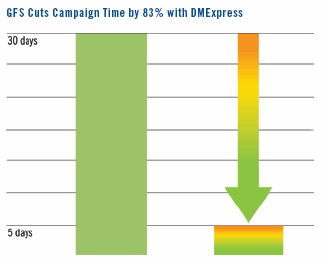CASE STUDY - A Global Financial Services Company Signs Up for Speed
By Lia Szep, Senior Technical Analyst, Syncsort Incorporated
We’ve all gotten the e-mails: a three-night stay on some island that you’ve never heard of, $50 off the latest everything-but-the-kitchen-sink cell phone, or a six-day cruise to anywhere. If you happen to love Bora Bora this time of year, want a cell phone that walks your dog, or think “anywhere” is better than here—you may be thinking “sign me up.” Believe it or not, there is big money to be made in people who want to go to Bora Bora—if you can find them. One century-old, global financial services company (which we call GFS) is doing just that.
Background
A data management group within GFS has been tasked, not with getting new customers, but with keeping current customers engaged. The group works to identify models of customer behavior by applying variables to customer data sets. They then run campaigns designed to cross-sell or up-sell with touch points that include e-mail, Web, and statement inserts. A refresh process uses the results of these campaigns to produce new variables, which are used to identify new models, which are the basis for new campaigns. And so runs the information delivery continuum.
Challenge
For a company like GFS, with 30-40 million active customers, 10,000 variables each, and double-digit terabytes of data, crunching these numbers was no small task. Using SAS to process everything—from the variables to the models to the data sets to the campaign lists—was taking 30 days. The refresh process, using DB2, which accounts for 95% of the feeds, was averaging 14 hours. They also have stringent SLAs. “If we miss the Monday deadline, we lose millions,” says the technical architect at GFS.

Figure 1: A campaign that once took 30 days to complete now takes five.
Solution
Facilitated by Syncsort’s DMExpress, the group went to work developing a confidential new architecture. Once in place, DMExpress was used to build the feeds and replace much of the SAS processing that created the data sets and campaign lists. A campaign that once took 30 days to complete now takes five. And with DMExpress now building the feeds, the refresh process is also significantly faster. The process that once took 14 hours now takes two. “We are in the position, using DMExpress and the new architecture, to run customer behavioral models in a half a minute,” says the architect. “Campaigns we were only able to run once a month, we now run four times a month. And that is only because our SLAs are once a week. If business users wanted it, we are positioned to run even more campaigns.”
In addition, GFS has benefited from DMExpress’s ease of use. For a group of command line users, the easy-to-use graphical user interface means more flexibility with staff. “With DMExpress, we can get new people up to date in two to three days,” the GFS architect says. “Now, when we have turnover, we don’t have to lose a base of valuable knowledge.”
DMExpress is currently being considered for other projects at GFS. And with the success easily measured in greater customer profitability, the architect, who runs “one of thousands of data warehouses” in the company, remains a staunch supporter of Syncsort and DMExpress.